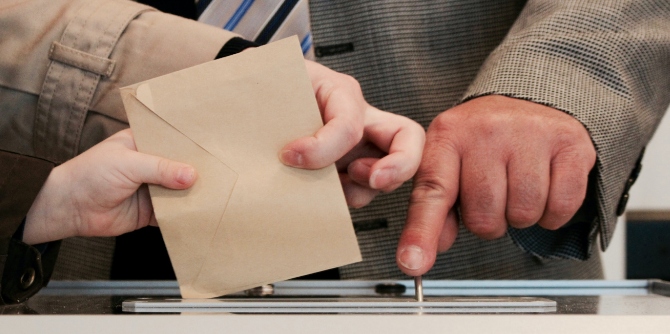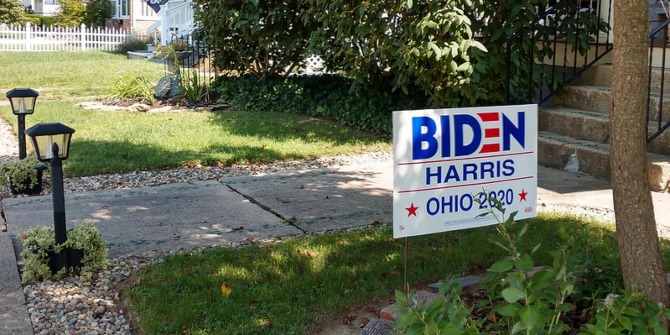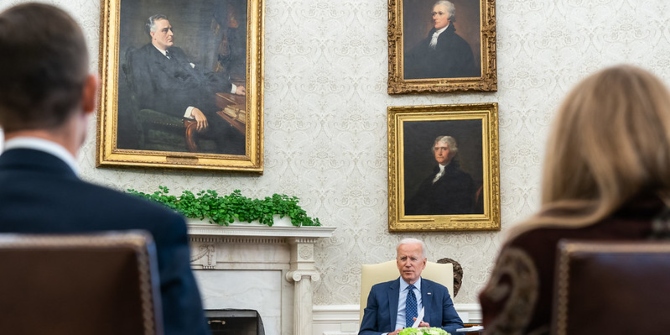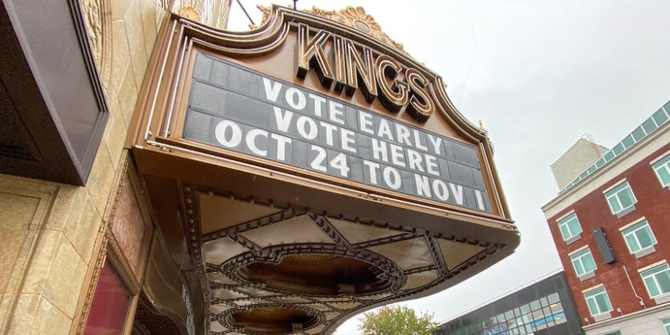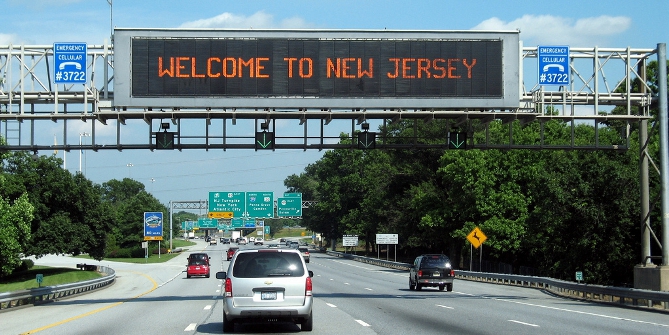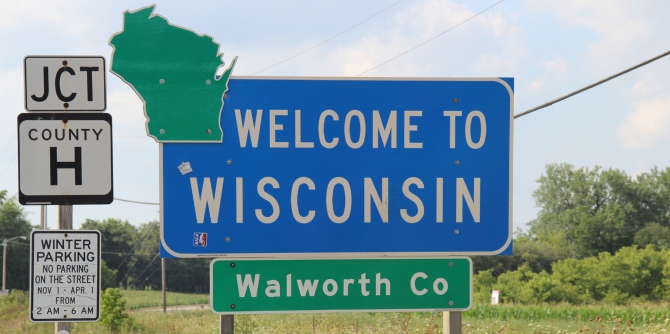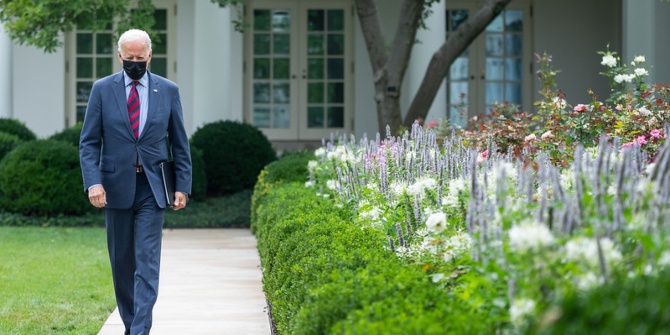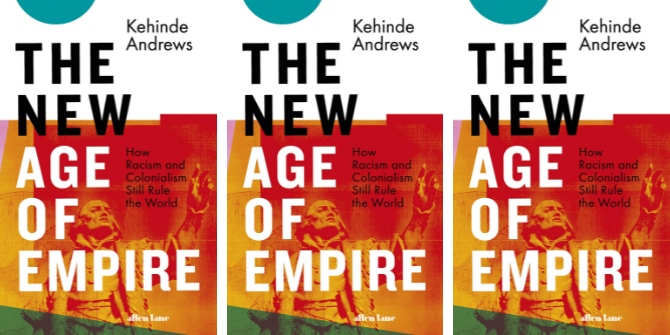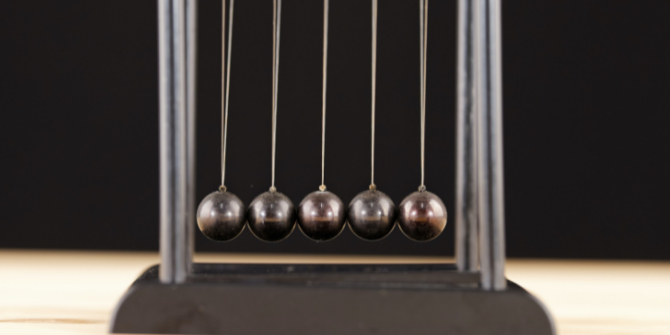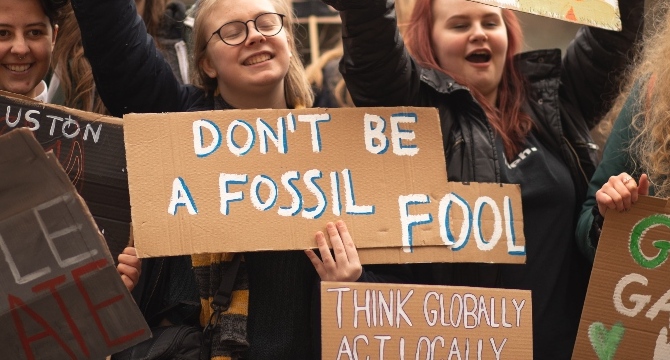 The Democratic Party recently announced that it would be shifting its presidential nominating convention back by more than a month because of concerns over COVID-19. James D. King writes that party reforms of the last 50 years mean that national conventions have become an advertisement for a pre-determined candidate rather than a venue to decide on the nominee. He comments that by moving their convention so close to the Republicans’, the Democrats’ nominee, Joe Biden, may miss out on a traditional post-convention poll bounce.
The Democratic Party recently announced that it would be shifting its presidential nominating convention back by more than a month because of concerns over COVID-19. James D. King writes that party reforms of the last 50 years mean that national conventions have become an advertisement for a pre-determined candidate rather than a venue to decide on the nominee. He comments that by moving their convention so close to the Republicans’, the Democrats’ nominee, Joe Biden, may miss out on a traditional post-convention poll bounce.
- This article is part of our Primary Primers series curated by Rob Ledger (Frankfurt Goethe University) and Peter Finn (Kingston University). Ahead of the 2020 election, this series explores key themes, ideas, concepts, procedures and events that shape, affect and define the US presidential primary process. If you are interested in contributing to the series contact (ledger@em.uni-frankfurt.de) or Peter Finn (p.finn@kingston.ac.uk).
The Democratic National Committee recently announced that its 2020 national convention has been rescheduled, shifting the dates from July 13-16 to August 17-20, due to the COVID-19 pandemic and associated restrictions on travel and social activities. This places the Democratic convention just one week before the Republican National Convention, scheduled for August 24-24. What effect this change will have on the outcome of the presidential election is uncertain. A party holding its nominating convention typically has the national media stage to itself, providing the party an opportunity to showcase its candidate and ideals. But as in many aspects of politics, timing is everything and the change in convention dates might be detrimental to former vice president Joe Biden’s chances of unseating President Donald Trump.
The role of parties’ national nominating conventions has changed. From their inception in the first half of the nineteenth century through the 1960s, conventions were truly deliberative bodies that selected their parties’ presidential and vice presidential candidates. A platform proclaiming a party’s stances on major policy questions was adopted and a candidate pledging support of the platform was nominated. Most delegates to the conventions were selected by local or state party leaders who in turn pledged their support, and the support of their delegations, to prospective nominees. Few delegates were selected through competitive primary elections. Representative of nomination campaigns of this era was John F. Kennedy’s bid for the Democratic Party’s nomination in 1960, when only sixteen states held primaries and just over a third of the delegates were selected through that method. Kennedy campaigned aggressively in the primary elections of Wisconsin and West Virginia, not to capture convention delegates but to demonstrate to party leaders that a Catholic from New England could win in the industrial Midwest and in a heavily Protestant state. Kennedy and his surrogates simultaneously met privately with Democratic leaders across the country to gain their support in the upcoming convention. (Kennedy’s successful strategy for securing the Democratic nomination is chronicled by Theodore H. White in his classic The Making of the President 1960).
Party reforms of the 1970s, with a majority of delegates chosen through primary elections and party caucuses and pledged to specific candidates, altered the role of national conventions. Now, one candidate accumulates enough pledged delegates to ensure the nomination. The party platform is written to conform to the prospective candidate’s positions with perhaps a plank or two added to secure the support of rivals for the nomination. The only suspense came with the selection of a vice presidential running mate but this has been eliminated by the practice of presumptive nominees announcing their choices before the convention. Thus, a convention now is a multi-day advertisement for the party and its nominee. National television networks have abandoned extensive convention coverage, leaving this to cable networks such as CNN and Fox News. The candidate’s acceptance speech, ostensibly to the delegates in the arena but truly to the national audience, is the only convention event guaranteed to receive maximum television exposure.
In light of what national party conventions have become, we must wonder what effect the five-week delay in the Democratic National Convention will have on the 2020 presidential election. Parties select their convention cities with an eye toward electoral gains in November. Academic research shows that a candidate gains little in the state that hosted the nominating convention, but for parties, hope springs eternal. Certainly Democrats expect meeting in Milwaukee this summer will bolster their candidate’s chances of winning Wisconsin (which Trump won by less than 25,000 votes in 2016) come November. The change of convention dates should have little bearing on this. Local media will cover the Democratic National Convention as extensively in August they would in July.
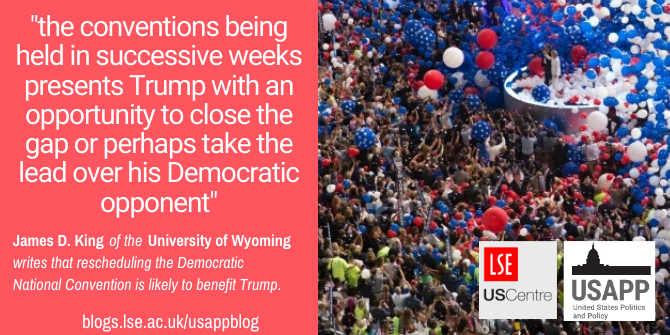
“The balloon drop at the end of the Democratic convention” by Lorie Shaull is licensed under CC-BY-SA-2.0
The uncertainty is the long-term effect of the change of dates for the Democratic National Convention. Presidential candidates typically get boosts from their parties’ conventions. With the national media stage to itself, a party highlights its ideals and showcases its presidential nominee. The result normally is a boost for the candidate but the magnitude of what is known as the “convention bounce” is affected by timing. By tradition the party not holding the White House holds its convention first and its candidate rises in the polls. The longer the time between the two parties’ conventions, the greater the opportunity the candidate has to solidify support garnered through the increased media exposure of the convention. Since 1976, the candidate whose party held its convention first had an average net gain in public support of three percentage points when the time between conventions was four weeks or more. When the conventions open just one week or two weeks apart, media attention shifts quickly from the candidate nominated at the first convention to the presumptive candidate of the second convention. The candidate nominated at the second convention gained an average of one and half percentage points through the process.
This raises the question of how rescheduling the Democratic National Convention affects Joe Biden’s challenge to Donald Trump. Most polls taken in late April and early May show Biden leading Trump but in many polls the difference is within the margin of error. The usual boost of three percentage points associated with long interludes between conventions would increase Biden’s lead in many polls beyond the margin of error. Instead, the conventions being held in successive weeks presents Trump with an opportunity to close the gap or perhaps take the lead over his Democratic opponent.
Much is uncertain as the two parties’ national conventions are still three months away. The COVID-19 crisis has the potential for disrupting “politics as usual” in the United States. It remains a top concern—perhaps the top concern—of voters and polls show more Americans disapproving the president’s response than approving. Nonetheless, historical trends suggest that Trump will benefit more than Biden by the change of dates for the Democratic National Convention.
Please read our comments policy before commenting.
Note: This article gives the views of the author, and not the position of USAPP– American Politics and Policy, nor of the London School of Economics.
Shortened URL for this post: https://bit.ly/2z0FOtg
About the author
 James D. King – University of Wyoming
James D. King – University of Wyoming
James D. King is professor of political science in the School of Politics, Public Affairs, and International Studies at the University of Wyoming. Recently he was a Fulbright scholar at Flinders University in Australia, researching how elements of the Australian electoral system might be used to reform American elections procedures.



